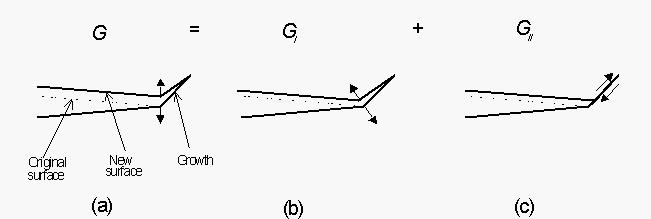FRACTURE CRITERION
In modelling fracture propagation in rock masses where both tensile and shear failure are common, a fracture criterion for predicting both mode I and mode II fracture propagation is needed. The exiting fracture criteria in the macro-approach can be classified into two groups: the principal stress (strain)-based criteria and the energy-based criteria. The first group consists of the Maximum Principal Stress Criterion and the Maximum Principal Strain Criterion; the second group includes the Maximum Strain Energy Release Rate Criterion (G-criterion) and the Minimum Strain Energy Density Criterion (S-criterion). The principal stress (strain)-based criteria are only applicable to the mode I fracture propagation which relies on the principal tensile stress (strain). To be applied for the mode II propagation, a fracture criterion has to consider not only the principal stress (strain) but also the shear stress (strain). From this point of view, the energy based criteria seem to be applicable for both mode I and II propagation because the strain energy in the vicinity of a fracture tip is related to all the components of stress and strain.
Both the G-criterion and the S-criterion have been examined for application to the mode I and mode II propagation (Shen and Stephansson, 1993), and neither of them is directly suitable. In a study by Shen and Stephansson (1993) the original G-criterion has been improved and extended. The original G-criterion states that when the strain energy release rate in the direction of the maximum G-value reaches the critical value Gc, the fracture tip will propagate in that direction. It does not distinguish between mode I and mode II fracture toughness of energy (GIc and GIIc). In fact, for themost of the engineering materials, the mode II fracture toughness is much higher than the mode I toughness due to the differences in the failure mechanism. In rocks, for instance, GIIc is found in laboratory scale to be at least two orders of magnitude higher than GIc (Li, 1991). Applied to the mixed mode I and mode II fracture propagation, the G-criterion is difficult to use since the critical value Gc must be carefully chosen between GIc and GIIc.
A modified G-criterion, namely the F-criterion, was proposed (Shen and Stephansson, 1993). Using the F-criterion the resultant strain energy release rate (G) at a fracture tip is divided into two parts, one due to mode I deformation (GI) and one due to mode II deformation (GII). Then the sum of their normalized values is used to determine the failure load and its direction. GI and GII can be expressed as follows (Figure 2-3): if a fracture grows an unit length in an arbitrary direction and the new fracture opens without any surface shear dislocation, the strain energy loss in the surrounding body due to the fracture growth is GI. Similarly, if the new fracture has only a surface shear dislocation, the strain energy loss is GII. The principles of the F-criterion can be stated as follows:

Figure 2-3. Definition of GI and GII for fracture growth. (a) G, the growth has both open and shear displacement; (b) GI, the growth has only open displacement; (c) GII, the growth has only shear displacement.
(1). In an arbitrary direction ![]() at a fracture tip there
exists a F-value, which is calculated by
at a fracture tip there
exists a F-value, which is calculated by
 2-16
2-16
(2). The possible direction of propagation of the fracture tip is the
direction ![]() for which the F-value reaches its maximum.
for which the F-value reaches its maximum.
![]() 2-17
2-17
(3). When the maximum F-value reaches 1.0, the fracture tip will propagate, i.e.
![]() 2-18
2-18
The F-criterion is actually a more general form of the G-criterion and it allows us to consider mode I and mode II propagation simultaneously. In most cases, the F-value reaches its peak either in the direction of maximum tension (GIc = maximum while GIIc=0) or in the direction of maximum shearing (GIIc = maximum while GIc=0). This means that a fracture propagation of a finite length (the length of an element, for instance) is either pure mode I or pure mode II. However, the fracture growth may socialite between mode I and mode II during an ongoing process of propagation, and hence form a path which exhibits the mixed mode failure in general.